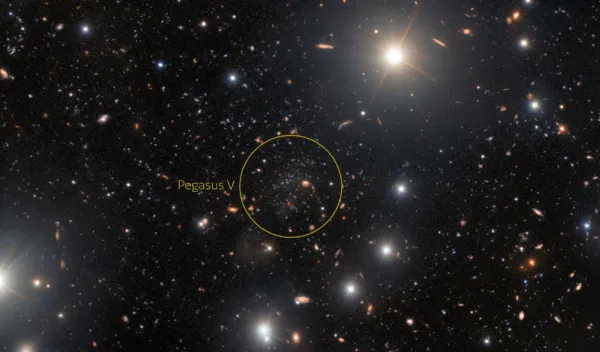
Faint fossil galaxy found at the Andromeda galaxy’s edge
An amateur astronomer examining archival data processed by the Community Science & Data Center tipped off astronomers about a smudge of interest in an image he examined as part of an effort by the Víctor M. Blanco 4-meter Telescope at Cerro Tololo Inter-American Observatory to search for dwarf galaxies.
Astronomers following up on the tip conducted observations using the Gemini North Telescope at the International Gemini Observatory, part of the U.S. National Science Foundation NOIRLab program. The astronomers confirmed that the dwarf galaxy at the far edges of the Andromeda galaxy, known as Pegasus V, is likely a fossil of the earliest galaxies.
"We have found an extremely faint galaxy whose stars formed very early in the history of the Universe," said Michelle Collins, an astronomer and lead author of a paper detailing the finding. "This discovery marks the first time a galaxy this faint has been found around the Andromeda Galaxy using an astronomical survey that wasn't specifically designed for the task."
Some of the faintest galaxies are thought to be the first galaxies formed and thus hold clues to the ancient universe. These cosmic relics are hard to find and harder to study, shrouding them in mystery.
"These extremely faint galaxies have very few of the bright stars we use to identify them and measure their distances," said Emily Charles, who was involved in the research. "Gemini's 8.1-meter mirror allowed us to find faint, old stars. That enabled us to measure the distance to Pegasus V and to determine that its stellar population is extremely old."
Relative to other faint galaxies around Andromeda, Pegasus V appears significantly older with a low presence of heavy metals, an indicator Pegasus V is a cluster of some of the earliest stars formed.
"We hope that further study of Pegasus V's chemical properties will provide clues into the earliest periods of star formation in the universe," said Collins. "This fossil galaxy from the early universe may help us understand how galaxies form, and whether our understanding of dark matter is correct."
"The enormous collecting area of the public-access Gemini North Telescope provides an array of capabilities for community astronomers," said Martin Still, NSF International Gemini Observatory program officer. "In this case, Gemini supported this team to confirm the presence of the dwarf galaxy, associate it physically with the Andromeda Galaxy, and determine the metal-deficient nature of its evolved stellar population."
Astronomers are continuing the search for faint galaxies and other cosmic artifacts that date back to the origins of the universe.
